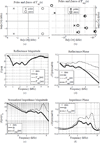Characterizing the ear canal acoustic impedance and reflectance by pole-zero fitting
- PMID: 23524141
- PMCID: PMC3733465
- DOI: 10.1016/j.heares.2013.03.004
Characterizing the ear canal acoustic impedance and reflectance by pole-zero fitting
Abstract
This study characterizes middle ear complex acoustic reflectance (CAR) and impedance by fitting poles and zeros to real-ear measurements. The goal of this work is to establish a quantitative connection between pole-zero locations and the underlying physical properties of CAR data. Most previous studies have analyzed CAR magnitude; while the magnitude accounts for reflected power, it does not encode latency information. Thus, an analysis that studies the real and imaginary parts of the data together, being more general, should be more powerful. Pole-zero fitting of CAR data is examined using data compiled from various studies, dating back to Voss and Allen (1994). Recent CAR measurements were taken using the Mimosa Acoustics HearID system, which makes complex acoustic impedance and reflectance measurements in the ear canal over a 0.2-6.0 [kHz] frequency range. Pole-zero fits to measurements over this range are achieved with an average RMS relative error of less than 3% with 12 poles. Factoring the reflectance fit into its all-pass and minimum-phase components estimates the effect of the residual ear canal, allowing for comparison of the eardrum impedance and admittance across measurements. It was found that individual CAR magnitude variations for normal middle ears in the 1-4 [kHz] range often give rise to closely-placed pole-zero pairs, and that the locations of the poles and zeros in the s-plane may systematically differ between normal and pathological middle ears. This study establishes a methodology for examining the physical and mathematical properties of CAR using a concise parametric model. Pole-zero modeling accurately parameterizes CAR data, providing a foundation for detection and identification of middle ear pathologies. This article is part of a special issue entitled "MEMRO 2012".
Copyright © 2013 Elsevier B.V. All rights reserved.
Figures








Similar articles
-
Ear-canal reflectance, umbo velocity, and tympanometry in normal-hearing adults.Ear Hear. 2012 Jan-Feb;33(1):19-34. doi: 10.1097/AUD.0b013e31822ccb76. Ear Hear. 2012. PMID: 21857517 Free PMC article. Clinical Trial.
-
An analysis of the acoustic input impedance of the ear.J Assoc Res Otolaryngol. 2013 Oct;14(5):611-22. doi: 10.1007/s10162-013-0407-y. Epub 2013 Aug 6. J Assoc Res Otolaryngol. 2013. PMID: 23917695 Free PMC article.
-
Sources of variability in reflectance measurements on normal cadaver ears.Ear Hear. 2008 Aug;29(4):651-65. doi: 10.1097/AUD.0b013e318174f07c. Ear Hear. 2008. PMID: 18600136
-
An overview of wideband immittance measurements techniques and terminology: you say absorbance, I say reflectance.Ear Hear. 2013 Jul;34 Suppl 1(0 1):9S-16S. doi: 10.1097/AUD.0b013e31829d5a14. Ear Hear. 2013. PMID: 23900187 Free PMC article. Review.
-
Assessment of ear disorders using power reflectance.Ear Hear. 2013 Jul;34 Suppl 1(7 0 1):48S-53S. doi: 10.1097/AUD.0b013e31829c964d. Ear Hear. 2013. PMID: 23900180 Free PMC article. Review.
Cited by
-
Pole-Zero Fitting for Transfer Function of Hearing-Aid Receiver: Evidence-Based Review.J Audiol Otol. 2018 Jul;22(3):111-119. doi: 10.7874/jao.2018.00073. Epub 2018 Jun 14. J Audiol Otol. 2018. PMID: 29890818 Free PMC article.
-
Procedures for ambient-pressure and tympanometric tests of aural acoustic reflectance and admittance in human infants and adults.J Acoust Soc Am. 2015 Dec;138(6):3625-53. doi: 10.1121/1.4936946. J Acoust Soc Am. 2015. PMID: 26723319 Free PMC article.
-
Reflectance measurement validation using acoustic horns.J Acoust Soc Am. 2015 Oct;138(4):2246-55. doi: 10.1121/1.4930948. J Acoust Soc Am. 2015. PMID: 26520306 Free PMC article.
-
Normative Wideband Reflectance, Equivalent Admittance at the Tympanic Membrane, and Acoustic Stapedius Reflex Threshold in Adults.Ear Hear. 2017 May/Jun;38(3):e142-e160. doi: 10.1097/AUD.0000000000000399. Ear Hear. 2017. PMID: 28045835 Free PMC article.
-
A comparison of ear-canal-reflectance measurement methods in an ear simulator.J Acoust Soc Am. 2019 Aug;146(2):1350. doi: 10.1121/1.5123379. J Acoust Soc Am. 2019. PMID: 31472530 Free PMC article.
References
-
- Allen J. Measurement of eardrum acoustic impedance. Peripheral Auditory Mechanisms. 1986;44
-
- Allen J, Jeng P, Levitt H. Evaluation of human middle ear function via an acoustic power assessment. Journal of Rehabilitation Research & Development. 2005;42:63–78. - PubMed
-
- Brune O. Synthesis of a finite two-terminal network whose driving-point impedance is a prescribed function of frequency. J of Math Phys. 1931;10:191–236.
-
- Farmer-Fedor B, Rabbitt R. Acoustic intensity, impedance and reflection coefficient in the human ear canal. The Journal of the Acoustical Society of America. 2002;112:600–620. - PubMed
-
- Feeney M, Grant I, Marryott L. Wideband energy reflectance measurements in adults with middle-ear disorders. Journal of Speech, Language, and Hearing Research. 2003;46:901–911. - PubMed
Publication types
MeSH terms
Grants and funding
LinkOut - more resources
Full Text Sources
Other Literature Sources

